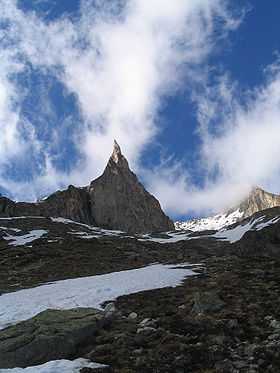Angelo Dibona

Angelo Dibona (1879–1956)[1] was an Italian mountaineer. He is remembered as one of the great pioneers of climbing in the Dolomites and is responsible for many first ascents throughout the Alps. The Aiguille Dibona in France and the Campanile Dibona in Italy are named after him.
Biography
Dibona was born in Cortina d'Ampezzo in 1879.[2][3] From 1905 he was a mountain guide and a ski instructor in the Cortina area, and he became known for pioneering routes in the Dolomites,[4][5] making more than 70 first ascents[1] and becoming the leading climber during the heyday of climbing in the Dolomites. In 1910 he made the second ascent of the Christomannosturm in the Trentino-Alto Adige/Südtirol, 13 years after its first ascent. Dibona's route included a 600 m (2,000 ft) high rock face with fifth-degree passages.[6] He made notable ascents of a number of peaks in other parts of the Alps in the early 1900s.[7]
One of his most notable first ascents was of the Pain de Sucre du Soreiller, a 3,130 m (10,270 ft) granite peak in the French Massif des Écrins, which he climbed in 1913 with Guido Mayer (an Austrian client with whom he climbed many peaks in the Dolomites and other parts of the Alps). This mountain was renamed the Aiguille Dibona in his honor.[8] Dibona developed a long-term and almost symbiotic friendship with Mayer and his brother.[9]
In the 1920s he climbed in the English Lake District, making first ascents of gills in the Honister Pass area.[10] In 1947 the Appalachian Mountain Club reported that Dibona was still doing "spectacular" rock climbs at the age of 65.[11]
Notable first ascents
- Campanile Dibona (west peak, 2,550 m (8,370 ft), Stubai Alps, 1908—solo)[12][13]
- Torre Fiscalina (Sexten Dolomites, 27 July 1909—with L. Rizzi, Guido Mayer, M. Mayer)[14]
- Einser/Cima Una (north face, Sexten Dolomites, 18 July 1910—with L. Rizzi, Guido Mayer, M. Mayer)[15]
- Croda dei Toni (2,945 m (9,662 ft), Sexten Dolomites, 22 July 1910—with L. Rizzi, Guido Mayer, M. Mayer)[16]
- Campanile Rosa (Tofane, 17 August 1910)[17]
- Tofana di Rozes (south-south-west, 3,225 m (10,581 ft), Tofane, 3 September 1930—with L. Apollonio and P.L. Edwards)[18]
- Punta Michele (north face, 2,898 m (9,508 ft), Stubai Alps, 1944—at age 65)[12]
References
- ↑ 1.0 1.1 Paci, Paolo (2003). Alpi: una grammatica d'alta quota. Feltrinelli Editore. p. 115. ISBN 978-88-7108-182-3.
- ↑ Schwaderer, Richard (1998). Italienbild und Stimme Italiens in den deutschsprachigen Kulturzeitschriften, 1945–1990: kommentierte Bibliographie. Gunter Narr Verlag. p. 323. ISBN 978-3-8233-5187-0.
- ↑ Scott, Doug K. (1979). Big wall climbing. Oxford UP. pp. 18–19.
- ↑ Collins, Martin; Gillian Price (2002). Treks in the Dolomites: Alta Via 1 and Alta Via 2. Cicerone Press. p. 11. ISBN 978-1-85284-359-5. Retrieved 1 December 2010.
- ↑ Messner, Reinhold (2001). The big walls: from the North Face of the Eiger to the South Face of Dhaulagiri. The Mountaineers Books. p. 42. ISBN 978-0-89886-844-9. Retrieved 1 December 2010.
- ↑ Tomasoni, Giuseppe (2001). Dolomiti in cartolina. ARCA SRL. p. 163. ISBN 978-88-88203-02-7.
- ↑ "New Expeditions in 1913". Alpine Journal 27: 435, 437. 1913. Retrieved 1 December 2010.
- ↑ Labande, François; Claude Dautrey, Christian Pichoud (2006). Randonnée pédestre dans le Parc National des Ecrins. Editions Olizane. p. 296. ISBN 978-2-88086-348-7. Retrieved 2 December 2010.
- ↑ Grupp, Peter (2008). Faszination Berg: die Geschichte des Alpinismus. Böhlau Verlag. p. 245. ISBN 978-3-412-20086-2.
- ↑ Evans, Brian (2005). Scrambles in the Lake District – North: 90 Classic Routes, Volume 2. Cicerone Press. pp. 135, 145–46. ISBN 978-1-85284-463-9.
- ↑ Appalachia, vol. 26. Appalachian Mountain Club. 1947. p. 394.
- ↑ 12.0 12.1 Klier, Walter (2006). Stubaier Alpen alpin: Alpenvereinsführer für Hochalpenwanderer und Bergsteiger. Bergverlag Rother. p. 373. Retrieved 1 December 2010.
- ↑ Galley, Hervé (2005). Escalade plaisir: Alpes Françaises du Nord: 114 voies du 4a au 6a/b d'accès aisé. Editions Olizane. p. 204. ISBN 978-2-88086-328-9.
- ↑ Klier, Walter (2006). Stubaier Alpen alpin: Alpenvereinsführer für Hochalpenwanderer und Bergsteiger. Bergverlag Rother. p. 180. ISBN 978-3-7633-1271-9.
- ↑ Klier, Walter (2006). Stubaier Alpen alpin: Alpenvereinsführer für Hochalpenwanderer und Bergsteiger. Bergverlag Rother. p. 187. ISBN 978-3-7633-1271-9.
- ↑ Klier, Walter (2006). Stubaier Alpen alpin: Alpenvereinsführer für Hochalpenwanderer und Bergsteiger. Bergverlag Rother. p. 216. ISBN 978-3-7633-1271-9.
- ↑ Klier, Walter (2006). Stubaier Alpen alpin: Alpenvereinsführer für Hochalpenwanderer und Bergsteiger. Bergverlag Rother. p. 431. ISBN 978-3-7633-1271-9.
- ↑ Klier, Walter (2006). Stubaier Alpen alpin: Alpenvereinsführer für Hochalpenwanderer und Bergsteiger. Bergverlag Rother. p. 405. ISBN 978-3-7633-1271-9.